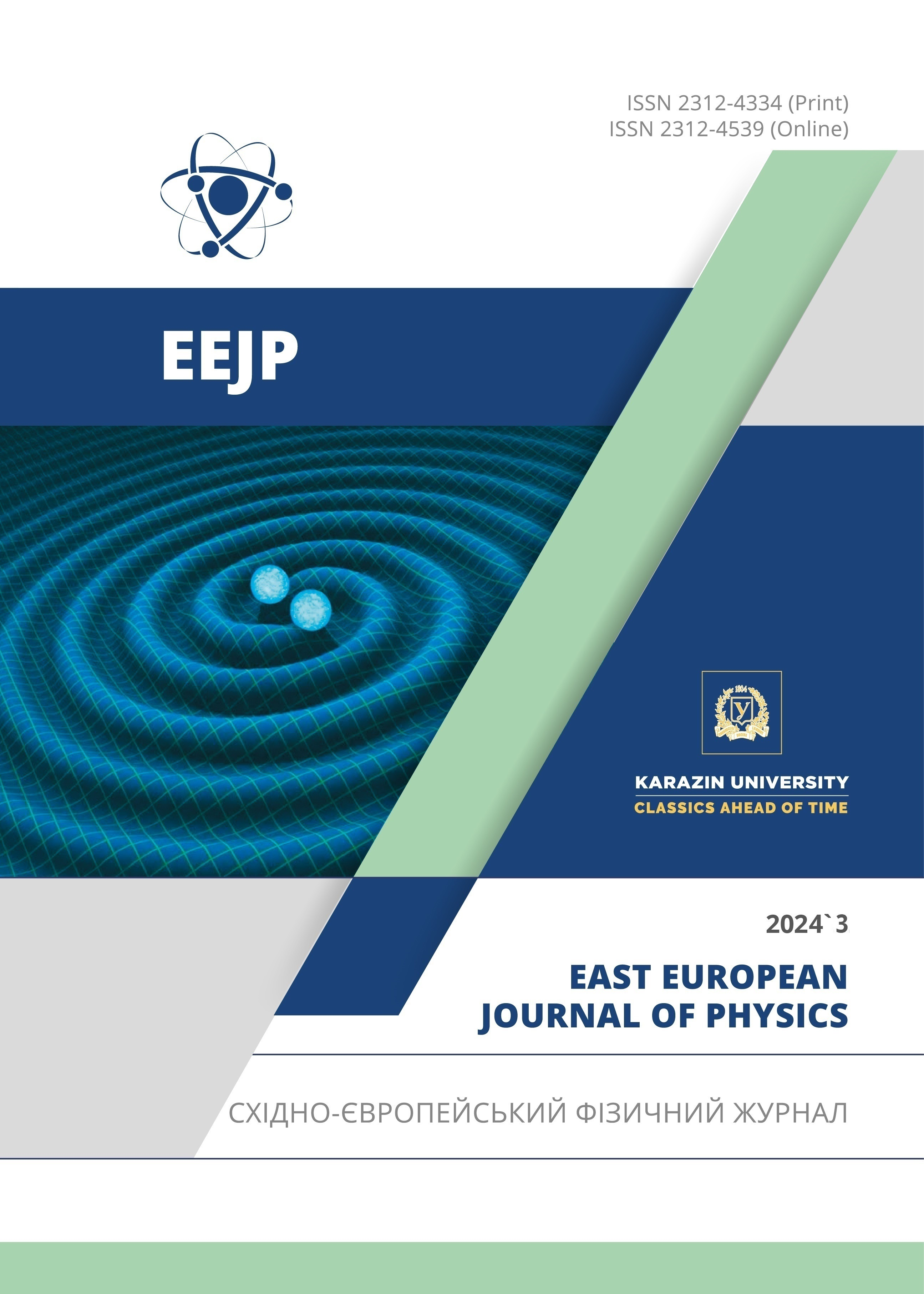Photoelectric Characteristics of the Heterojunction n-GaAs-p-(GaAs)1-x-y(Ge2)x(ZnSe)y
Abstract
The photoelectric properties of n-GaAs – p-(GaAs)1–x–y(Ge2)x(ZnSe)y heterostructures have been investigated both in photodiode and photovoltaic modes. It has been revealed that the spectral dependence of the photocurrent covers a wide range of energy intervals, ranging from 1.07 eV to 3 eV. It has been demonstrated that as the temperature of the crystallization onset (Toc) increases, the peaks of the spectral dependencies of the photoelectromotive force (photo-EMF) shift towards shorter wavelengths. It has been observed that as the crystallization onset temperature (Toc) of the solid solution layer (GaAs)1–x–y(Ge2)x(ZnSe)y increases, the lifetime of photo carriers increases from 10-7 s at Toc=650°C to 5·10-5 s at Toc=730°C. It is demonstrated that the peaks of the intrinsic photoluminescence band shift towards shorter wavelengths with an increase in the temperature of the crystallization onset. Additionally, the study of the intrinsic spectral region of photoluminescence in samples across the thickness of the epitaxial layer confirms the variability of the obtained structures.
Downloads
References
W. Yang at. el, “Pseudobinary Solid-Solution: An Alternative Way for the Bandgap Engineering of Semiconductor Nanowires in the Case of GaP–ZnSe,” Advanced Functional Materials, 25(17), 2543 (2015). https://doi.org/10.1002/adfm.201404523
A. Kosarev, V. Chaldysheva, V. Preobrazhenskii, M. Putyato, and B. Semyagin. “Effect of a Low-Temperature-Grown GaAs Layer on InAs Quantum-Dot Photoluminescence,” Semiconductors, 50(11), 1519 (2016). https://doi.org/10.1134/S1063782616110154
M. Szot, et al. “Experimental and Theoretical Analysis οf PbTe-CdTe Solid Solution Grown by Physical Vapour Transport Method,” Acta Physica Polonica A, 116(5), 959 (2009).
A. Reznitskya, A. Klochikhina, and M. Eremenko. “Thermally Activated Resonance Tunneling in Asymmetric Systems of CdSe/ZnSe Double Quantum Wells with Self Assembled Quantum Dots,” Semiconductors, 48(3), 345 (2014). https://doi.org/10.1134/S1063782614030221
A. Sharma, and T. Das. “Electronic band structure and optical properties of GaAsSb/GaAs for optoelectronic device applications: A 14 band k.p study,” Optical Materials, 112, 110734 (2021). https://doi.org/10.1016/j.optmat.2020.110734
P. Sanmartin, F. Almonacid, M. Ceballos, A. Garcia-Loureiro, and E. Fernandez, “Wide-bandgap III-V materials for high efficiency air and underwater optical photovoltaic power transmission,” Solar Energy Materials and Solar Cells, 266, 112662 (2024). https://doi.org/10.1016/j.solmat.2023.112662
A. Yachmenev, S. Pushkarev, R. Reznik, R. Khabibullin, and D. Ponomarev, “Arsenides-and related III-V materials-based multilayered structures for terahertz applications: Various designs and growth technology,” Progress in Crystal Growth and Characterization of Materials, 66, 100485 (2020). https://doi.org/10.1016/j.pcrysgrow.2020.100485Get rights and content
N. Papez, R. Dallaev, ¸S. Talu, and J. Kastyl. “Overview of the Current State of Gallium Arsenide-Based Solar Cells (Review),” Materials, 14, 3075 (2021). https://doi.org/10.3390/ma14113075
J. Geisz, R. France, K. Schulte, M. Steiner, A. Norman, H. Guthrey, M. Young, et al., “Six-junction III–V solar cells with 47.1% under 143 Suns concentration,” Nat. Energy, 5(4), 326–335 (2020). https://doi.org/10.1038/s41560-020-0598-5
S. Zaynabidinov, A. Saidov, A. Boboev, and D. Abdurahimov, “Structure, Morphology and Photoelectric Properties of n-GaAs-p-(GaAs)1--x(Ge2)х Heterostructure,” Herald of the Bauman Moscow State Technical University, Series Natural Sciences, 100(1), 72-87 (2022). https://doi.org/10.18698/1812-3368-2022-1-72-87
S. Zainabidinov, A. Saidov, M. Kalanov, and A. Boboev, “Synthesis, Structure and Electro-Physical Properties n-GaAs–p-(GaAs)1–x–y(Ge2)x(ZnSe)y Heterostructures (Review)”. Applied Solar Energy, 55, 291–308 (2019). https://doi.org/10.1038/s41560-020-0598-510.3103/S0003701X1905013X
S. Suprun, V. Sherstyakova, and E. Fedosenko. “Epitaxial Growth of ZnSe on GaAs with the Use of the ZnSe Compound as the Source”. Semiconductors, 43(11),1526–1531(2009) https://doi.org/10.1134/S1063782609110220
S. Khludkov, O. Tolbanov, M. Vilisova, and I. Prudaev, Semiconductor devices based on gallium arsenide with deep impurity centers, (Publishing House of Tomsk State University, Tomsk, 2016).
D. Bletskan, J. Madyar, and V. Kabaciy, “Effect of Nonstoichiometry and Doping on the Photoconductivity Spectra of GeSe Layered Crystals,” Semiconductors, 40(2), 137–142 (2006) https://doi.org/10.1134/S1063782606020047.
S. Zainabidinov, Sh. Utamuradova, and A. Boboev, “Structural Peculiarities of the (ZnSe)1–x–y(Ge2)x(GaAs1–δBiδ)y Solid Solution with Various Nanoinclusions,” Journal of Surface Investigation X-ray Synchrotron and Neutron Techniques, 16(6), 1130-1134 (2022). https://doi.org/10.1134/S1027451022060593
Copyright (c) 2024 Akramjon Y. Boboev

This work is licensed under a Creative Commons Attribution 4.0 International License.
Authors who publish with this journal agree to the following terms:
- Authors retain copyright and grant the journal right of first publication with the work simultaneously licensed under a Creative Commons Attribution License that allows others to share the work with an acknowledgment of the work's authorship and initial publication in this journal.
- Authors are able to enter into separate, additional contractual arrangements for the non-exclusive distribution of the journal's published version of the work (e.g., post it to an institutional repository or publish it in a book), with an acknowledgment of its initial publication in this journal.
- Authors are permitted and encouraged to post their work online (e.g., in institutional repositories or on their website) prior to and during the submission process, as it can lead to productive exchanges, as well as earlier and greater citation of published work (See The Effect of Open Access).








